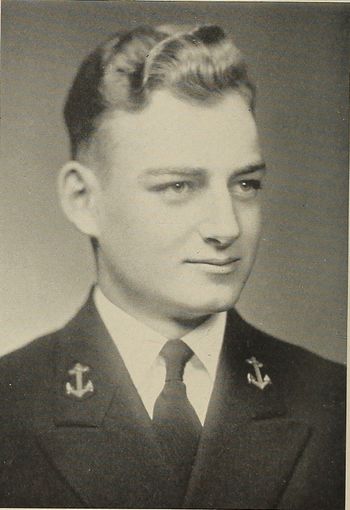JOHN M. ENNIS, LCDR, USN
John Ennis '35
Lucky Bag
From the 1935 Lucky Bag:
JOHN MATTHEW ENNIS
Lewistown, Montana
"John" "Radical"
THERE are almost six feet more of this Westerner that the photo doesn't show, and which his opponents on the football field have had a hard time seeing until after the accident. In John, the profession of arms acclaims a member who is also adept with the pen; a pleasantly impedantic student in whose intellectual world academics occupy only the smallest part. Time, carrying away with it all superficialities, has shown to us a man to whom the shortness of this sketch does an injustice, whose animated interest in the world as he finds it is a constant source of delight, and whose kindly patience, thoughtful encouragement, and downright loyalty have made him an indispensable support to a blundering roommate.
Football 4, 3, 2, 1. 1 P. O.

JOHN MATTHEW ENNIS
Lewistown, Montana
"John" "Radical"
THERE are almost six feet more of this Westerner that the photo doesn't show, and which his opponents on the football field have had a hard time seeing until after the accident. In John, the profession of arms acclaims a member who is also adept with the pen; a pleasantly impedantic student in whose intellectual world academics occupy only the smallest part. Time, carrying away with it all superficialities, has shown to us a man to whom the shortness of this sketch does an injustice, whose animated interest in the world as he finds it is a constant source of delight, and whose kindly patience, thoughtful encouragement, and downright loyalty have made him an indispensable support to a blundering roommate.
Football 4, 3, 2, 1. 1 P. O.
Loss
John was lost on July 15, 1943 when his plane crashed into a hill in Fremont State Park, near Hollister, California. The other officer aboard was also killed. They were flying from Alameda Naval Air Station. (Information from the Oakland Tribune on July 18, 1943.)
Other Information
He was commanding officer of Composite Squadron (VC) 39; this squadron was later aboard USS Liscome Bay (CVE 56) when she was sunk with large loss of life in November 1943.
John was born in Washington and entered the Naval Academy from Iowa.
From researcher Kathy Franz:
John was a graduate of Fergus high school and was appointed to the Naval Academy by Senator T. J. Walsh.
He was survived by his parents, Matt and Elizabeth Ennis of Seattle, a brother Ensign Matt Ennis, Jr., and a sister, Mrs. Stafford Hansell. Another brother, Captain Robert Ennis, was a prisoner of the Japanese in the Philippines.
He is buried in Washington.
Wartime Experience
From the Fresno Bee on April 11, 1943:
On a little knoll in an isolated spot in Latin America, in a group of thatched huts and tents, a fighting United States Navy outfit has built a smooth working, hard hitting base and a great record in combatting Nazi submarines.
The U boars were plentiful when the first members of the squadron arrived to find cows grazing contentedly on a pasture that has become their airport.
Heading the squadron was Lieutenant John Matthew Ennis of Lewistown, Mont., a graduate of the Naval Academy.
The outfit is far from the war fronts of North Africa, or China or the Southwest Pacific, but the job is a big one because if it were not for such squadrons fewer prime necessities of war would reach the United States for battlefield equipment, and the economy of a continent would get a rude jolt.
Hardly had the squadron arrived at its buildingless base when it got word of submarines and started after them. Not a single ship has been sunk in the patrol area of this land based navy squadron since, and not a pilot has been lost.
"We've been pretty lucky on both counts," says Ennis.
He cannot do any talking about submarines and what may have happened to them, but he makes no secret of the fact he has "a great bunch of aviators and other officer and enlisted personnel, each one of whom has done his job to keep things going."
His next in command is Lieutenant J. H. Graves of Darlington, S. C., who saw fighting experience in the Southwest Pacific. Two other righthand men are Lieutenant Ralph Lincoln (Pesky) Werner of Dayton, Ohio, who in days past achieved fame as a football player at University of Dayton, and as an amateur boxer, and Lieutenant Edward Walter Pacek of Worcester, Mass.
The men came here at a time when personnel and supplies were short. They had to shift for themselves. Tropical skies are not always moonlit and enchanting. The sun beams down fiercely in the day time, and in the rainy season, "The water comes down in bucketsful," as Lieutenant Robert Jeline Perkinson of Pleasantville, N. Y., expresses it.
Must Fight Lizards
Added to that, they had to combat malaria, scorpions, mosquitoes, and sand flies, and keep lizards out of their beds.
Today the camp is a neat little community which pops up surprisingly into view from the air – a community of rows of tents and thatched huts.
The nearest village is several miles away and is the nearest railway connection to a tropical metropolis where some of the boys go on weekends.
Lieutenant Milton Swift Worley of Bothell, Wash., shows home made movies in the cool of the evening. Worley took motion pictures of the early days at the base here – of men bathing in an outdoor shower or in a nearby stream, of a Christmas tree trimly decorated and looking strangely out of place beneath a warm sun. Also there are movies by Worley of the days when he was in training at Corpus Christi, Texas, and Pensacola, Fla.; of a visit to Coney Island and Times Square.
One gets the distinct impression the pictures have been seen many times before, but the audience Is attentive. There are occasional comments, however, such as "Watch Brunmier (Lieutenant Carland Edward Brunmier of Bloomington, Calif.) gawking at the sights." And suddenly Brunmier appears smiling in a palm lined garden, ablaze with flowers and tropical shrubs.
Lieutenant Commander Donald H. MacDonald, who formerly was an eye, ear, nose and throat specialist in Boston, Mass., and on the staffs of the general hospital there, and on the faculty of Harvard Medical School, is camp physician. He tries to read, and the youngsters kid him about how the mosquitos like him but he keeps the crew healthy.
Perhaps the most impressive thing about the base is the fine morale. The men work amazingly hard when the situation requires, and play just as hard. There is Richard Arthur Breitenbach from Pittsburgh, former district agent for an electric refrigerator concern. The boys call him "the genius" because he can fix anything.
There is Charles Treadway of Ravenna, Ky., an aviation chief machinist mate, whose great beard is the pride of the camp. His fellows call him "el toro" (the bull) because of his powerful build and capacity for work.
The submarines may be back some day. But if the boys who watch the waterways in other areas are as good as are the men here, there will not be a repetition of those days of last year when the airways were full of SOS calls from ships torpedoed near shore.
He was commanding officer of Scouting Squadron (VS) 2D7; as of September 1, 1942 it was flying from San Julian, Cuba. (Unknown if this is the "isolated spot in Latin America" in the article above.) He was commanding officer of Scouting Squadron (VS) 40 from March 1, 1943 to May 22, 1943 — it appears VS-40 was the renamed VS-2D7.
Related Articles
Joseph Castello '39 was a member of Composite Squadron (VC) 39 when he was killed in October; it's unclear if he and John served together.
The "Register of Commissioned and Warrant Officers of the United States Navy and Marine Corps" was published annually from 1815 through at least the 1970s; it provided rank, command or station, and occasionally billet until the beginning of World War II when command/station was no longer included. Scanned copies were reviewed and data entered from the mid-1840s through 1922, when more-frequent Navy Directories were available.
The Navy Directory was a publication that provided information on the command, billet, and rank of every active and retired naval officer. Single editions have been found online from January 1915 and March 1918, and then from three to six editions per year from 1923 through 1940; the final edition is from April 1941.
The entries in both series of documents are sometimes cryptic and confusing. They are often inconsistent, even within an edition, with the name of commands; this is especially true for aviation squadrons in the 1920s and early 1930s.
Alumni listed at the same command may or may not have had significant interactions; they could have shared a stateroom or workspace, stood many hours of watch together, or, especially at the larger commands, they might not have known each other at all. The information provides the opportunity to draw connections that are otherwise invisible, though, and gives a fuller view of the professional experiences of these alumni in Memorial Hall.
October 1935
January 1936
LTjg Eugene Davis '27 (Observation Plane Squadron (VO) 4B)
April 1936
July 1936
January 1937
April 1937
September 1937
January 1938
July 1938
LT Renwick Calderhead '27
LTjg Samuel Dealey '30
LTjg John Huntley '31
LTjg Albert Gray '31
LTjg George Ottinger '32
LTjg William Widhelm '32
ENS Glenn Dunagan '33
January 1939
LT Renwick Calderhead '27
LT Samuel Dealey '30
LTjg John Huntley '31
LTjg Albert Gray '31
LTjg William Thorn '32
LTjg Glenn Dunagan '33
CAPT Paul Moret '30 (Training Squadron (VN) 3D8)
LT Alden Irons '31 (Training Squadron (VN) 3D8)
LTjg William Widhelm '32 (Training Squadron (VN) 5D8)
2LT Ralph Haas '36 (Marine Barracks)
October 1939
LTjg George Nicol '34 (Scouting Squadron (VS) 3)
ENS Raymond Vogel, Jr. '36 (Fighting Squadron (VF) 3)
ENS William Mason, Jr. '37 (USS Saratoga)
ENS John Black '38 (USS Saratoga)
ENS Keene Hammond '38 (USS Saratoga)
ENS Lenard Reichel '39 (USS Saratoga)
ENS Claude Goodman, Jr. '39 (USS Saratoga)
ENS Norman White '39 (USS Saratoga)
June 1940
LT William Sisko '31 (Scouting Squadron (VS) 3)
LT John Spiers '32 (Fighting Squadron (VF) 3)
LTjg George Nicol '34 (Scouting Squadron (VS) 3)
ENS Edward O'Hare '37 (Fighting Squadron (VF) 3)
ENS Keene Hammond '38 (USS Saratoga)
ENS Norman White '39 (USS Saratoga)
November 1940
LT William Sisko '31 (Scouting Squadron (VS) 3)
LTjg Raymond Vogel, Jr. '36 (Fighting Squadron (VF) 3)
LTjg Harold Shrider '37 (Scouting Squadron (VS) 3)
LTjg Edward O'Hare '37 (Fighting Squadron (VF) 3)
LTjg Macdonald Thompson '37 (Torpedo Squadron (VT) 3)
ENS Norman White '39 (USS Saratoga)
April 1941
LT William Pennewill '29
LT Finley Hall '29
LT John Yoho '29
LT William Sisko '31
LT George Bellinger '32
LT Martin Koivisto '32
LT John Spiers '32
LT Archibald Greenlee '32
LT Daniel Gothie '32
LT Albert Major, Jr. '32
LTjg John McCormack, Jr. '33

The "category" links below lead to lists of related Honorees; use them to explore further the service and sacrifice of alumni in Memorial Hall.